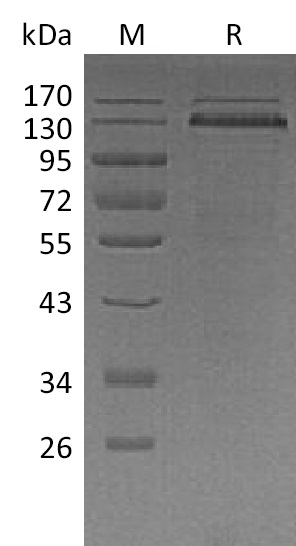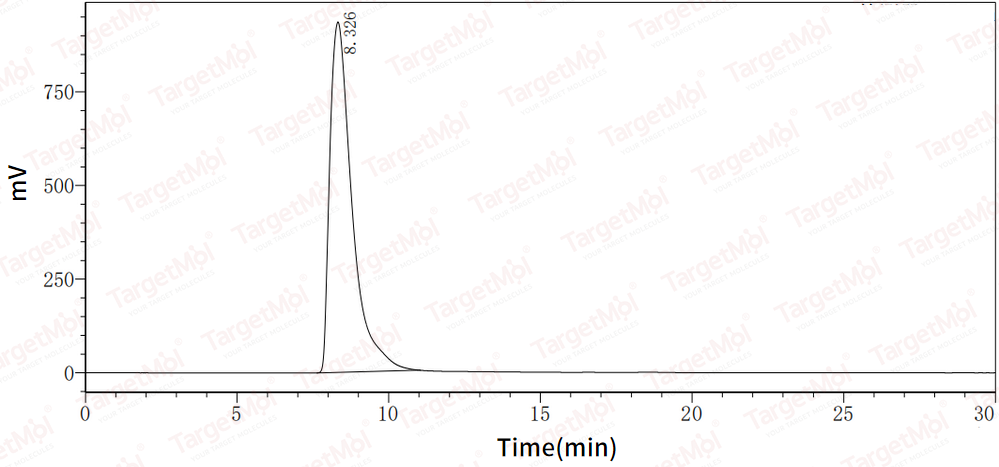 Your shopping cart is currently empty
Your shopping cart is currently empty
THBS1 Protein, Human, Recombinant (His)
Thrombospondin-1 (TSP-1) is a 150-180kDa calcium-sensitive protein that is secreted as a disulfide-linked homotrimer. TSP-1 regulates a wide range of cellular functions including their interactions with other cells and with the extracellular matrix (ECM). TSP-1 contains an N-terminal Laminin G-like globular domain, an extended central region with one vWFC domain, 3 TSP type 1domains, 2 EGF-like domains, and 8 TSP type3 domains, and a globular TSP C-terminal domain. Distinct regions of TSP-1 have been associated with binding to particular ECM or cellular molecules. TSP-1 counteracts the angiogenic, hypotensive, and antithrombotic effects of nitric oxide (NO). It binds and neutralizes VEGF, blocks VEGF R2 signaling on vascular endothelial cells(EC), and destabilizes adhesive contacts between EC. TSP-1 also plays an important role in wound repair and tissue fibrosis by binding latent TGF-beta and inducing release of the active cytokine from the latency associated peptide (LAP).

THBS1 Protein, Human, Recombinant (His)
| Pack Size | Price | USA Warehouse | Global Warehouse | Quantity |
|---|---|---|---|---|
| 5 μg | $68 | - | In Stock | |
| 10 μg | $110 | - | In Stock | |
| 20 μg | $169 | 7-10 days | 7-10 days | |
| 50 μg | $310 | 7-10 days | 7-10 days | |
| 100 μg | $532 | 7-10 days | 7-10 days | |
| 200 μg | $919 | 7-10 days | 7-10 days | |
| 500 μg | $1,900 | 7-10 days | 7-10 days | |
| 1 mg | $2,730 | 7-10 days | 7-10 days |
Product Information
| Biological Activity | Activity has not been tested. It is theoretically active, but we cannot guarantee it. If you require protein activity, we recommend choosing the eukaryotic expression version first. |
| Description | Thrombospondin-1 (TSP-1) is a 150-180kDa calcium-sensitive protein that is secreted as a disulfide-linked homotrimer. TSP-1 regulates a wide range of cellular functions including their interactions with other cells and with the extracellular matrix (ECM). TSP-1 contains an N-terminal Laminin G-like globular domain, an extended central region with one vWFC domain, 3 TSP type 1domains, 2 EGF-like domains, and 8 TSP type3 domains, and a globular TSP C-terminal domain. Distinct regions of TSP-1 have been associated with binding to particular ECM or cellular molecules. TSP-1 counteracts the angiogenic, hypotensive, and antithrombotic effects of nitric oxide (NO). It binds and neutralizes VEGF, blocks VEGF R2 signaling on vascular endothelial cells(EC), and destabilizes adhesive contacts between EC. TSP-1 also plays an important role in wound repair and tissue fibrosis by binding latent TGF-beta and inducing release of the active cytokine from the latency associated peptide (LAP). |
| Species | Human |
| Expression System | HEK293 Cells |
| Tag | C-10xHis |
| Accession Number | P07996 |
| Synonyms | TSP1,TSP,Thrombospondin-1,THBS1 |
| Construction | Asn19-Pro1170 |
| Protein Purity | Greater than 85% as determined by reducing SDS-PAGE. Greater than 80% as determined by SEC-HPLC.   |
| Molecular Weight | 130&170 KDa (reducing condition) |
| Endotoxin | < 0.1 ng/µg (1 EU/µg) as determined by LAL test. |
| Formulation | Lyophilized from a solution filtered through a 0.22 μm filter, containing 20 mM PB, 8% Trehalose, 4% Mannitol, 200 mM NaCl, 0.02% Tween 80, pH6.5. |
| Reconstitution | Reconstitute the lyophilized protein in distilled water. The product concentration should not be less than 100 μg/ml. Before opening, centrifuge the tube to collect powder at the bottom. After adding the reconstitution buffer, avoid vortexing or pipetting for mixing. |
| Stability & Storage | Lyophilized powders can be stably stored for over 12 months, while liquid products can be stored for 6-12 months at -80°C. For reconstituted protein solutions, the solution can be stored at -20°C to -80°C for at least 3 months. Please avoid multiple freeze-thaw cycles and store products in aliquots. |
| Shipping | In general, Lyophilized powders are shipping with blue ice. Solutions are shipping with dry ice. |
| Research Background | Thrombospondin-1 (TSP-1) is a 150-180kDa calcium-sensitive protein that is secreted as a disulfide-linked homotrimer. TSP-1 regulates a wide range of cellular functions including their interactions with other cells and with the extracellular matrix (ECM). TSP-1 contains an N-terminal Laminin G-like globular domain, an extended central region with one vWFC domain, 3 TSP type 1domains, 2 EGF-like domains, and 8 TSP type3 domains, and a globular TSP C-terminal domain. Distinct regions of TSP-1 have been associated with binding to particular ECM or cellular molecules. TSP-1 counteracts the angiogenic, hypotensive, and antithrombotic effects of nitric oxide (NO). It binds and neutralizes VEGF, blocks VEGF R2 signaling on vascular endothelial cells(EC), and destabilizes adhesive contacts between EC. TSP-1 also plays an important role in wound repair and tissue fibrosis by binding latent TGF-beta and inducing release of the active cytokine from the latency associated peptide (LAP). |
Dose Conversion
Calculator
Tech Support
| Size | Quantity | Unit Price | Amount | Operation |
|---|

Copyright © 2015-2025 TargetMol Chemicals Inc. All Rights Reserved.



